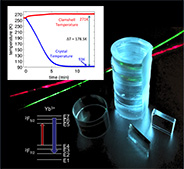Going Below 100 Kelvin: UNM Team Achieves New World Record in Laser Cooling of Solids
May 30, 2014

Figure: Image of Yb:YLF crystals used for Optical Refrigeration. Inset top: cooling performance of a 10% Yb:YLF crystal reaching 93K after 7 minutes. Inset bottom: Energy level diagram of Yb3+. Pumping at the E4-E5 transition (red arrow up) allows for optimal cooling. Fluorescence (blue arrow down) energy is increased by the annihilation of phonons, the vibrational energy in the crystal.
While scientists can use mechanical refrigerators to reach cryogenic temperatures, some applications suffer from a significant drawback, vibrations. Especially in optical measurements, vibrations cause noise that cannot always be mitigated. In addition, these vibrations cause wear, reducing the lifetime of the refrigerator itself. Dealing with these drawbacks becomes increasingly important as measurement sensitivity increases or where parts cannot be easily replaced. Space-based applications suffer from both drawbacks. The solution is solid-state cryogenic refrigeration. Until now, the only solid-state refrigeration available was thermo-electric coolers (TECs), which operate based on the Peltier effect. While TECs work well for a range of applications, they are only capable of reaching about -100 0C (170 K), far above the necessary cryogenic temperatures required. Recently a new method of cryogenic solid-state refrigeration has been achieved at the University of New Mexico, laser cooling of solids.
Solid-state laser cooling (a.k.a. optical refrigeration) is based on the principle of anti-Stokes fluorescence where laser photons with energy less than the mean fluorescence energy are absorbed followed by phonon-assisted upconversion fluorescence. In other words, a high power laser, tuned to the correct wavelength, induces cooling by generating a fluorescence that escapes a solid with higher power than the absorbed laser power! The increased fluorescence power is created by the removal of vibrational energy in the solid, making it cold.
Headed by Prof. Mansoor Sheik-Bahae, UNM's team has made a number of major milestones in this field in the recent years by concentrating their efforts on ytterbium-doped fluoride crystals, namely Yb:YLF. Since breaking the so-called "Peltier barrier" in 2010 by cooling this crystal to 155K (from room temperature) the team has continued its success by lowering the temperature and increasing the cooling power. Most recently, UNM team has achieved cooling down to -180°C (93 K), a temperature just above the liquid oxygen! This represents a new world record not only for optical refrigeration but the coldest temperature achieved in a truly all-solid-state manner, without cryogens or any mechanical moving part. These results show exciting potentials for realizing a compact and vibration-free all-solid-state cryocooler with applications ranging from space-born sensors, superconducting electronics to super-stable lasers for optical metrology.
The solid-state laser cooling research at UNM involves major national and international partners and collaborations. In addition to current UNM group (postdocs Seth Melgaard, and Alex Albrecht, and graduate students Mohammadreza Ghasemkhani, Nathan Gianinni, and Saeid Rostami), ongoing efforts in advancing the field also involves active collaboration with Dr. Richard Epstein (Thermo-Dynamic Films, LLC), Dr. Markus Hehlen (Los Alamos National Lab), Dr. Denis Seletskiy (Univ. Konstanz, Germany), Dr. Mauro Tonelli (Univ. of Pisa, Italy), Dr. Jeff Cederberg (Sandia National Lab), Mr. Tom Fraser (AFRL), Prof. Yemane Asmerom and Dr. Victor Polyak (UNM's Department of Earth and Planetary Sciences).
